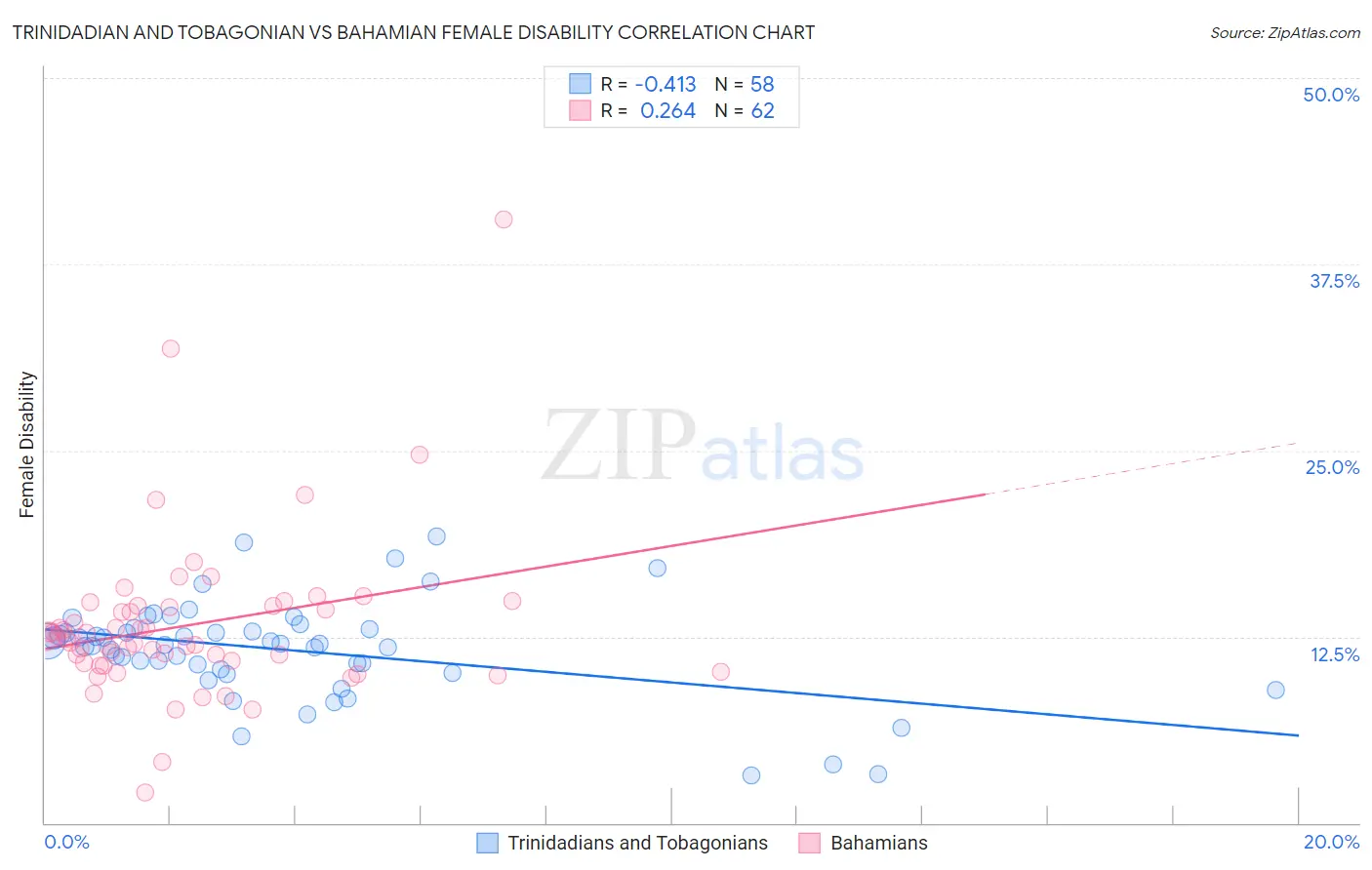Trinidadian and Tobagonian vs Bahamian Female Disability
COMPARE
Trinidadian and Tobagonian
Bahamian
Female Disability
Female Disability Comparison
Trinidadians and Tobagonians
Bahamians
12.3%
FEMALE DISABILITY
22.4/ 100
METRIC RATING
200th/ 347
METRIC RANK
12.4%
FEMALE DISABILITY
11.1/ 100
METRIC RATING
220th/ 347
METRIC RANK
Trinidadian and Tobagonian vs Bahamian Female Disability Correlation Chart
The statistical analysis conducted on geographies consisting of 219,838,071 people shows a moderate negative correlation between the proportion of Trinidadians and Tobagonians and percentage of females with a disability in the United States with a correlation coefficient (R) of -0.413 and weighted average of 12.3%. Similarly, the statistical analysis conducted on geographies consisting of 112,675,688 people shows a weak positive correlation between the proportion of Bahamians and percentage of females with a disability in the United States with a correlation coefficient (R) of 0.264 and weighted average of 12.4%, a difference of 0.78%.

Female Disability Correlation Summary
| Measurement | Trinidadian and Tobagonian | Bahamian |
| Minimum | 3.2% | 2.1% |
| Maximum | 19.2% | 40.5% |
| Range | 16.0% | 38.4% |
| Mean | 11.6% | 13.3% |
| Median | 12.0% | 12.4% |
| Interquartile 25% (IQ1) | 10.3% | 10.8% |
| Interquartile 75% (IQ3) | 13.0% | 14.5% |
| Interquartile Range (IQR) | 2.7% | 3.8% |
| Standard Deviation (Sample) | 3.3% | 5.6% |
| Standard Deviation (Population) | 3.3% | 5.5% |
Demographics Similar to Trinidadians and Tobagonians and Bahamians by Female Disability
In terms of female disability, the demographic groups most similar to Trinidadians and Tobagonians are Chinese (12.3%, a difference of 0.010%), Somali (12.3%, a difference of 0.040%), Immigrants from Barbados (12.3%, a difference of 0.070%), Immigrants from Zaire (12.3%, a difference of 0.080%), and Immigrants from Grenada (12.4%, a difference of 0.10%). Similarly, the demographic groups most similar to Bahamians are European (12.4%, a difference of 0.090%), Immigrants from Bahamas (12.4%, a difference of 0.12%), British (12.4%, a difference of 0.14%), Immigrants from Burma/Myanmar (12.4%, a difference of 0.19%), and Panamanian (12.4%, a difference of 0.20%).
| Demographics | Rating | Rank | Female Disability |
| Trinidadians and Tobagonians | 22.4 /100 | #200 | Fair 12.3% |
| Chinese | 22.1 /100 | #201 | Fair 12.3% |
| Somalis | 21.5 /100 | #202 | Fair 12.3% |
| Immigrants | Barbados | 21.1 /100 | #203 | Fair 12.3% |
| Immigrants | Zaire | 20.9 /100 | #204 | Fair 12.3% |
| Immigrants | Grenada | 20.5 /100 | #205 | Fair 12.4% |
| Immigrants | Cuba | 20.2 /100 | #206 | Fair 12.4% |
| Croatians | 20.2 /100 | #207 | Fair 12.4% |
| Basques | 17.5 /100 | #208 | Poor 12.4% |
| Mexicans | 15.7 /100 | #209 | Poor 12.4% |
| Swiss | 14.9 /100 | #210 | Poor 12.4% |
| Immigrants | Bosnia and Herzegovina | 14.8 /100 | #211 | Poor 12.4% |
| Ute | 14.7 /100 | #212 | Poor 12.4% |
| Immigrants | Thailand | 14.5 /100 | #213 | Poor 12.4% |
| Panamanians | 13.5 /100 | #214 | Poor 12.4% |
| Samoans | 13.4 /100 | #215 | Poor 12.4% |
| Immigrants | Burma/Myanmar | 13.3 /100 | #216 | Poor 12.4% |
| British | 12.7 /100 | #217 | Poor 12.4% |
| Immigrants | Bahamas | 12.5 /100 | #218 | Poor 12.4% |
| Europeans | 12.1 /100 | #219 | Poor 12.4% |
| Bahamians | 11.1 /100 | #220 | Poor 12.4% |